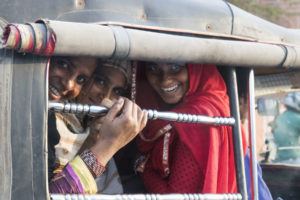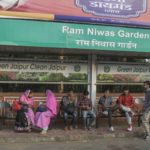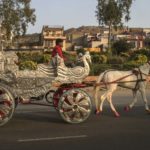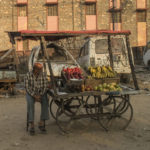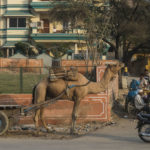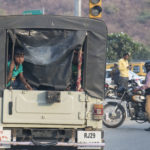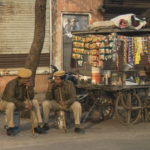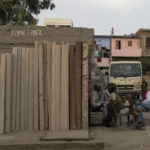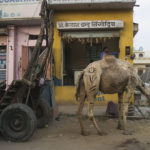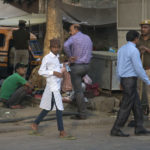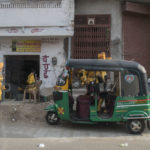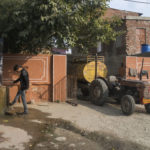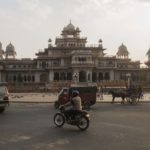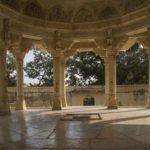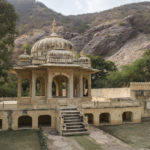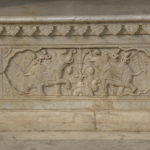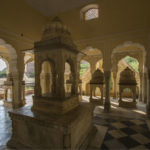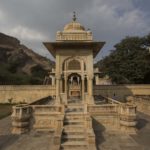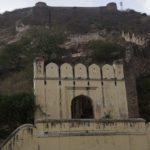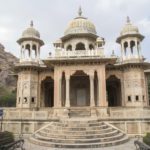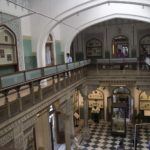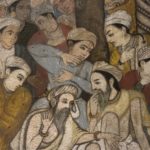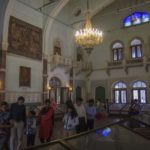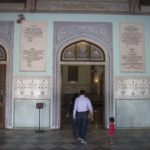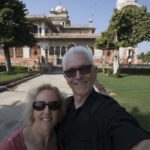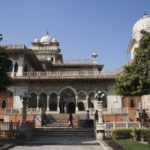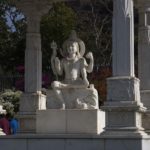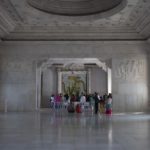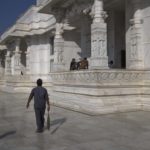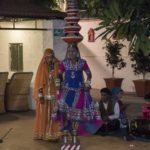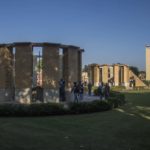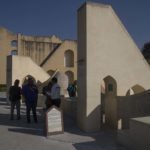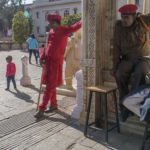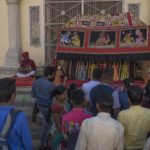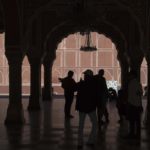City Palace
The first thing that appealed to us about this tourist attraction was the simple fact that we could pay our entrance fees with credit card! This may sound like a small thing, but with the cash crisis in India, this was VERY helpful. ATMs were usually empty before 9am, and there is a cap on exchanging cash – only 5,000 Rps per person per WEEK, with a signed declaration kept on file to prevent more exchanges.
A colourful puppet show greeted us as we walked through the gateway towards the museum section housed in the Chandra Mahal, with many in the audience capturing the traditional artform on video on their phones.
The museum itself contained portraits of the all maharjas of Jaipur. One ruler, Jai Singh II (who also built the palace), was particularly rotund – he was 2m tall and 1.2m wide! He apparently fathered “around 125” children with his 27 wives (who knows how many concubines he had!). But he was also a progressive ruler, banning Sati (widows immolating themselves after their husband’s deaths), child marriages, and curbing wasteful expenditure on flash weddings (I think that one may have been ignored through time!).
Jai Singh II’s interest in science and culture left a great legacy, including the observatory at the palace – Jantar Mantar, which is full of gigantic instruments for astronomical observation. While this is an UNESCO site, it actually looks like a funky, modern art sculpture garden. His interest in astronomy and the calculations to determine auspicious dates for important occasions, led him to the decision that the nation needed to be educated in this science. This is still a strong focus for all Indian people when determining weddings and other significant events.
The main part of the City Palace, is still home to the Maharajas of Jaipur. The current ruler (who turned 18 this year), is usually in the UK studying at university, but is home for Christmas (indicated by the flag flying – the universal sign that the monarch is in residence). This young man ascended the thrown at only 13 years of age when his grandfather, Sawai Man Singhji Bahadur II, died at the age of 80.
Driving through Jaipur
The drive back to our lodgings at Pearl Palace Heritage took us through some areas of the city receiving ‘make overs’. Unfinished grey concrete buildings with their “crew cuts” of spiky, reinforced steel popping out of the top were a common sight. As was glimpses of assorted animals scavenging along the side of the road, baby pigs swinging their tails like excited puppies, snouts into the rubbish.
Unlike our previous night’s experience at the Peacock Rooftop Restaurant at Pearl Palace Hotel, our choice for dinner proved disappointing. We were after a dinner and show combination to sample both local food and dance. The owner of our tour company wanted our driver to take us to Indiana, which had mixed reviews on TripAdvisor. And we could see why. The food was average and double the price of Peacock Rooftop Restaurant, which had delicious dishes. The only positive aspect of the Indiana was the entertainment – the musicians and dancers were great. After returning to our hotel and speaking to Paresh on the desk, I would’ve much rather have gone to one of the ones he was recommending.
Birla Mandir Temple
While the pristine-white Birla Mandir Temple is officially a multi-faith place of worship, there is clearly a strong Hindu influence in architecture and traditions. Understandably, it is very popular, and as such has a shoe depository – 1 rp per pair of shoes (about 2 cents!).
No photographs were allowed inside, but there was plenty to admire. The carvings were intricate and beautiful, the sun hitting the white marble accentuating the symbols and forms with shadows. The three small porticos on both sides of the temple provided lovely spots for devotees to rest and chat in the winter sun.
Even the approach to this temple had been thought about carefully – the stone and cement retaining wall was dotted with holes in which were planted many colourful bougainvilleas.
Albert Hall
The Albert Hall of Jaipur is nothing like Albert Hall in London. And it was also named after a different Albert – Victoria and Albert’s son, the Prince of Wales, rather than the prince consort. Its architectural style is known as Indo-Saracenic (or Indo-Gothic), which “represents a synthesis of Muslim designs and Indian materials developed by British architects in India during the late nineteenth and early twentieth centuries. The hybrid combined diverse architectural elements of Hindu and Mughal with Gothic cusped arches, domes, spires, tracery, minarets and stained glass, in a wonderful, almost playful manner.” [Henry Irwin, architect]
It is actually the State Museum of Rajasthan, not a concert hall (like its ‘namesake’ in London), and is filled with an important and rich collection of carpets, paintings, stone, ivory, crystal and metal sculptures.
Royal Gaitor
The location of the royal cenotaphs was a peaceful and surprisingly tourist-free spot, recommended to our driver, Anand, by another driver friend of his. Our guy continues to go above and beyond to make our experience of India as memorable as possible. Often, visitors don’t spend as much time in one spot as we like to do, so sometimes the biggies are the first and only things on the list.
This is where the male royal family members are commemorated, their mausoleums (or chhatris) standing nobly in cream marble. The best thing about the Royal Gaitor is the solitude. India is full of magnificent architecture, but it is rare indeed to experience it alone! There was only one young couple that were enjoying sitting shoulder to shoulder unchaperoned in the second courtyard, and then as we were leaving, a young family arrived. Apart from that, nothing. Just us and the chhatris. All this beauty for 60 cents entry fee. AND no hawkers!! Lovely!
Farewell, Jaipur
Jaipur is a city of many facets, some more charming than others. I enjoyed the early morning salesmen on bikes and trailers with their ‘call-answer’ singing of their touting song to sell their wares of pots and pans and anything else they had on their carts. We couldn’t quite see them from our corner balcony in the Pearl Palace Heritage, but we enjoyed their refrain.
What I do not understand is the love of pigeons in this city – maybe they are considered ‘lucky’ animals? In Venice, these creatures are called ‘flying rodents’ and are culled in the early mornings before the tourists awake. In Jaipur, they FEED them…and they are EVERYWHERE!
But Jaipur is definitely a city where you could easily pass weeks and not experience all that it has to offer. I look forward to our return, and I will be staying once more at the Pearl Palace Heritage Boutique Guesthouse.
Our Indian journey continues with Mandawa…
Accommodation: Pearl Palace Heritage Boutique Guesthouse, Jaipur (read our article on the Pearl Palace Heritage)
Tour Company: Intense India Tours
Read our full Jaipur story here:
Part 1: Amber City & Fort
Part 2 (current): City Palace, Albert Hall, Royal Gaitor
Click on any image below to view as gallery
- Bus stop, Jaipur
- Wedding carriage, Jaipur
- Fruit stall, Jaipur
- Camel in harness, Jaipur
- Passenger peaking out of truck, Jaipur
- Uniformed men at ease, Jaipur
- Men at work, Jaipur
- Decorated camel, Jaipur
- Street scene, Jaipur
- Brass band, Jaipur
- Shoe cleaning in Jaipur
- Smiling trio in tuk tuk, Jaipur
- The Albert Hall, Jaipur
- Rotunda in the Royal Gaitor, Jaipur
- Chhatris at the Royal Gaitor, Jaipur
- Detail of carving at the Royal Gaitor, Jaipur
- Royal chhatris at the Royal Gaitor, Jaipur
- Chhatris of Jai Singh II in Jaipur
- The view of the wall of Amber City from the Royal Gaitor, Jaipur
- The Royal Gaitor, Jaipur
- Roof kite flyer, Jaipur
- Three rosy saris, Jaipur
- Traffic and elephant, Jaipur
- Family transport, Jaipur
- Interior of Albert Hall, Jaipur
- Detail of mural at Albert Hall, Jaipur
- The carpet room in Albert Hall, Jaipur
- Entry to Albert Hall, Jaipur
- Nic and John outside Albert Hall, Jaipur
- Side entrance of Albert Hall, Jaipur
- Hanging on tightly, Jaipur
- Shrine at Birla Mandir Temple, Jaipur
- Interior of Birla Mandir Temple from the doorway, Jaipur
- Birla Mandir Temple, Jaipur
- Pot dancing in Jaipur
- Barber at work in Jaipur
- Tuk tuk to work, Jaipur
- Cheeky monkeys in Jaipur
- Astronomical park, Jantar Mantar, Jaipur
- Jantar Mantar, Jaipur
- Gatekeepers at City Palace, Jaipur
- Puppet show at City Palace, Jaipur
- Silhouettes at City Palace, Jaipur

